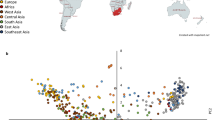Summary
Soybean RFLP markers have been primarily developed and genetically mapped using wide crosses between exotic and adapted genotypes. We have screened 38 soybean lines at 128 RFLP marker loci primarily to characterize germ plasm structure but also to evaluate the utility of RFLP markers identified in unadapted populations. Of these DNA probes 70% detected RFLPs in this set of soybean lines with an average polymorphism index of 0.30. This means that only 1 out of 5 marker loci was informative between any particular pair of adapted soybean lines. The variance associated with the estimation of RFLP genetic distance (GDR) was determined, and the value obtained suggested that the use of more than 65–90 marker loci for germ plasm surveys will add little precision. Cluster analysis and principal coordinate analysis of the GDR matrix revealed the relative lack of diversity in adapted germ plasm. Within the cultivated lines, several lines adapted to Southern US maturity zones also appeared as a separate group. GDR data was compared to the genetic distance estimates obtained from pedigree analysis (GDP). These two measures were correlated with r = 0.54 for all 38 lines, but the correlation increased to r = 0.73 when only adapted lines were analyzed.
Similar content being viewed by others
References
Apuya N, Frazier BL, Keim P, Roth EJ, Lark KG (1988) Restriction length polymorphisms as genetic markers in soybean, Glycine max (L.) Merr. Theor Appl Genet 75:889–901
Burr B, Burr FA, Thompson KA, Albertson MC, Stuber CW (1988) Gene mapping with recombinant inbreds in maize. Genetics 118:519–526
Chatfield C, Collins AJ (1980) Introduction to multivariate analysis. Chapman and Hall, New York, pp 189–210
Delannay X, Rodgers DM, Palmer RG (1983) Relative genetic contribution among ancestral lines to North American soybean cultivars. Crop Sci 23:944–949
Feinberg AP, Vogelstein B (1983) A technique for radiolabelling DNA restriction endonuclease fragments to a high specific activity. Anal Biochem 132:6–13
Helentjaris T (1987) A genetic linkage map for maize base upon RFLPs. Trends Genet 3:217–221
Jeffreys AJ, Wilson V, Thein SL (1985) Individual specific fingerprints of human DNA. Nature 316:76–79
Keim P, Shoemaker RC (1988) construction of a random recombinant DNA library that is primarily single copy sequence. Soybean Genet Newsl 15:147–148
Keim P, Olson TC, Shoemaker RC (1988) A rapid protocol for isolating soybean DNA. Soybean Genet Newsl 15:150–152
Keim P, Shoemaker RC, Palmer RG (1989) RFLP diversity in soybean. Theor Appl Genet 77:786–792
Keim P, Diers BW, Olson TC, Shoemaker RC (1990 a) RFLP mapping in soybean: Association between marker loci and variation in quantitative traits. Genetics 126:735–742
Keim P, Diers BW, Shoemaker RC (1990 b) Genetic analysis of soybean hard seededness with molecular markers. Theor Appl Genet 79:465–469
Landry BS, Kesseli RV, Farrara B, Michelmore RW (1987) A genetic map of lettuce (Lactuca sativa L.) with restriction fragment length polymorphism, isozyme, disease resistance and morphological markers. Genetics 116:331–337
Maniatis T, Fritsch EF, Sambrook J (1982) Molecular cloning: a laboratory manual. Cold Spring Harbor Laboratory Press, Cold Spring Harbor, N.Y
Marshall DR, Allard RW (1970) Isozyme polymorphisms in natural populations of Avena fatua and A. barbata. Heredity 25:373–382
Nei M (1973) Analysis of gene diversity in subdivided populations. Proc Natl Acad Sci USA 70:3321–3323
Nei M, Lei W-H (1979) Mathematical model for studying genetic variation in terms of restriction endonucleases. Proc Natl Acad Sci USA 76:5256–5273
Nienhuis J, Helentjaris T, Slocum M, Ruggero B, Schaefer A (1987) Restriction fragment length polymorphism analysis of loci associated with insect resistance in tomato. Crop Sci 27:797–803
Patterson AH, Lander ES, Hewitt JD, Peterson S, Lincoln SE, Tanksley SD (1988) Resolution of quantitative traits into Mendelian factors, using a complete linkage map of restriction fragment length polymorphisms. Nature 335:721–726
Quenouille M (1956) Notes on bias in estimation. Biometrika 43:253–260
Smith OS, Smith JSC, Bowen SL, Tenborg RA, Wall SJ (1990) Similarities among a group of elite maize inbreds as measured by pedigree, F1 grain yield, heterosis, and RFLPs. Theor Appl Genet 80:833–840
Weir B (1990) Genetic data analysis: methods for discrete population genetic data. Sinauer Assoc, Sunderland, Mass., pp 124–134
Author information
Authors and Affiliations
Additional information
Communicated by A.L. Kahler
Rights and permissions
About this article
Cite this article
Keim, P., Beavis, W., Schupp, J. et al. Evaluation of soybean RFLP marker diversity in adapted germ plasm. Theoret. Appl. Genetics 85, 205–212 (1992). https://doi.org/10.1007/BF00222861
Accepted:
Issue Date:
DOI: https://doi.org/10.1007/BF00222861




